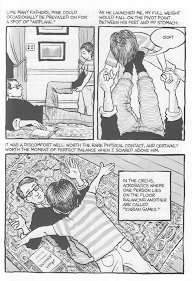"Icarian Games"

Alison Bechdel begins and ends her graphic novel Fun Home with the Greek myth of Daedalus and Icarus. Her perspective of the myth changes, however, as she grows older. In her early childhood, Bechdel is only a spectator of her father’s struggles as she depicts him as both Daedalus and Icarus. Daedalus was a builder; he created the labyrinth for the minotaur and Icarus’ wings. In similar fashion, Bechdel’s father is building the family house, and she calls him “a Daedalus of decor” (Bechdel 6). Bechdel also gives him the title of “artificer.” It implies that unlike Daedalus, her father’s creation is not just a project but a camouflage. Her father is unable to come out as gay because society was not as receptive at the time, so his painstaking work on the house is how he artfully tries to cover his identity. The house is not only how he expresses himself, but it is also his attempt at creating the image of a normal family where he is a ...